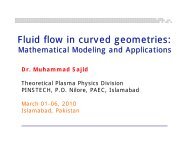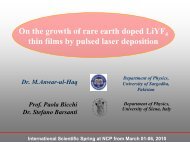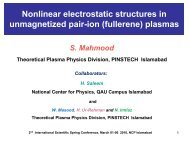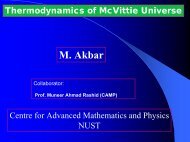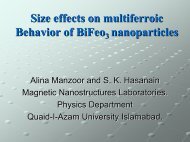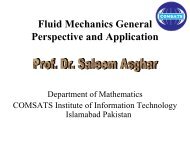Dr. Abdul Ahad
Dr. Abdul Ahad
Dr. Abdul Ahad
You also want an ePaper? Increase the reach of your titles
YUMPU automatically turns print PDFs into web optimized ePapers that Google loves.
An Overview of 5MV<br />
Pelletron Accelerator at<br />
NCP<br />
<strong>Dr</strong>. <strong>Abdul</strong> <strong>Ahad</strong>
Contents<br />
• Electrostatic Accelerators<br />
• 5UDH-2 Pelletron at NCP<br />
– introduction<br />
– Control System<br />
– Ion Sources<br />
– RC43 Setup<br />
– RS61 Setup<br />
• Applications (Ion Beam Analysis)
Electrostatic Accelerators<br />
• True DC<br />
• Low Energy Spread<br />
• Current<br />
• All Masses<br />
100% duty cycle<br />
100e V to few KeV<br />
(1 MeV to 100’s s MeV)<br />
nano to micro amp<br />
(Mass independent)<br />
3
Electrostatic Accelerators<br />
Single Ended<br />
• Higher Currents<br />
• Ne, Ar, Xe<br />
• Less energy spread (microprobes)
Electrostatic Accelerators<br />
Tandem<br />
• Source, etc. outside accelerator tank<br />
• No molecular interferences - He++ vs. H2+<br />
• Flexibility – Multiple sources<br />
• Easy to upgrade<br />
• Higher E for Vt, especially for heavy ions<br />
THE NCP 5UDH-2 IS A TANDEM
Electrostatic Accelerators<br />
Belt Charging system<br />
Current transported by belt<br />
Characteristics of Ideal Belt<br />
- high resistivity<br />
- little stretch<br />
- moisture resistant<br />
- smooth surface<br />
- sufficient mechanical strength<br />
• Dust Generation
Electrostatic Accelerators
Electrostatic Accelerators<br />
• Pelletron charging System By NEC (1960)<br />
• Metal cylinders with rounded ends joined by nylon<br />
• Move at at bout 15 m/s<br />
• Delivers charging currents of 100 - 200 µA<br />
• motors are supported on movable platforms which<br />
are counterweighted, automatically providing proper<br />
chain tension
Electrostatic Accelerators<br />
Pelletron Chain<br />
• Spark damage well<br />
protected.<br />
• Better voltage stability.<br />
- High efficiency.<br />
- Insensitive to moisture.<br />
- Long life (50,000 hours).<br />
- Simple and reliable.<br />
- Go to over 30 MV
Pelletron Charging<br />
11
The NCP 5UDH-2 2 PELLETRON<br />
• 5 MV Terminal Voltage<br />
• Dual Ion Sources<br />
– SNICS II for wide range of light and heavy ions<br />
– RF-Charge Exchange for He<br />
• Beam currents<br />
– 5 – 10 microamps for most probable charge states,<br />
– 100's of pA for high charge state heavy ions<br />
• Energies<br />
– 10 MeV for Protons, 15 MeV for He++<br />
– Useful currents for heavy ions to over 50 MeV<br />
• 15 degree beamline for Materials Analysis<br />
• 30 degree beamline for Ion Scattering/Nuclear Physics<br />
13
The NCP 5 MV Pelletron
The NCP 5 MV Pelletron<br />
15
The NCP 5 MV Pelletron<br />
16
The NCP 5 MV Column<br />
17
Control system<br />
Control & Data<br />
Acquisition<br />
• LINUX based<br />
computer user<br />
interface<br />
• MCA CARDS for data<br />
acquisition<br />
18
Control system
Beam Energy<br />
• Tandem accelerates the negative ion to the<br />
positive terminal<br />
• Then strips to many charge states, Q<br />
• Each state picks up Q x MV<br />
• Total Energy = (Q+1)MV<br />
• Charge state probability depends on terminal<br />
voltage, ion mass, and stripper<br />
20
Beam Currents<br />
• The next slide shows the wide variety of<br />
beam energies and currents from a<br />
tandem at 3MV<br />
• Higher energies are possible in the 5UDH<br />
21
ION SOURCES<br />
• The purpose of the ions sources are to<br />
produce either positive or negative ions<br />
from neutral atoms of elements of interest.<br />
• the ions beams are injected to the<br />
accelerator tube for gaining high energy.<br />
23
SNICS II Ion Source<br />
• “Source of Negative Ions by Cesium<br />
Sputtering” from solid materials.<br />
• Cs ions from hot “ionizer” surface are<br />
accelerated to the cathode.<br />
• Cathode contains element (s) for beams.<br />
• Simple operation; rapid cathode change.<br />
• Currents up to 100's of micoramps<br />
depending on material.<br />
24
SNICS II Ion Sources
Principle Of Operation<br />
• Cs vapor comes from the cesium oven into<br />
an enclosed area between the cooled<br />
cathode and the heated ionizing surface.<br />
• Some of the cesium condenses on the<br />
front of the cathode and some of the<br />
cesium is ionized by the hot surface.<br />
26
Cont..<br />
• The ionized cesium accelerates towards the<br />
cathode, sputtering particles from the cathode<br />
through the condensed cesium layer.<br />
• Some materials will preferentially sputter<br />
negative ions.<br />
• Other materials will preferentially sputter neutral<br />
or positive particles which pick up electrons as<br />
they pass through the condensed cesium layer,<br />
producing negative ions.<br />
27
SNICS II Ion Sources<br />
28
Alphatross Ion Sources
RF Charge Exchange Source<br />
30
Operation Principle<br />
• There are two main components in this device.<br />
The first one is the radio frequency positive ion<br />
source.<br />
• Helium gas is bled into a quartz discharge bottle<br />
through a metering valve to maintain a pressure<br />
of 10-50 millitorr.<br />
• An RF oscillator induces a plasma in the bottle<br />
which is intensified by the solenoid magnet.<br />
31
Cont..<br />
• A DC potential is applied across the<br />
plasma by probe power supply.<br />
• This potential extracts ions from the<br />
plasma and accelerates them through the<br />
Ta exit canal.<br />
• Then they enter the charge exchange<br />
chamber.<br />
32
Cont..<br />
• The charge exchange is the second main<br />
component of the Alphatross.<br />
• In it He + ions are neutralized by Rb vapor.<br />
• A few He atoms then undergo a 2 nd charge<br />
exchange reaction and become negative<br />
He ions.<br />
33
RF Charge Exchange Source<br />
Schematic<br />
34
15 Degree NEC RC43 Setup<br />
• RBS with channeling<br />
• Elastic Recoil Detection (ERD)<br />
– Surface hydrogen analysis<br />
• Nuclear Reaction Analysis<br />
(NRA)<br />
– Element specific analysis<br />
– E.g.:<br />
• 15N + H (Hydrogen depth<br />
profiling)<br />
• 4He + 16O (enhanced<br />
oxygen detection)<br />
• Particle Induced X-Ray<br />
Emission (PIXE)<br />
• Particle Induced Gamma<br />
Emission (PIGE)<br />
– Trace element analysis<br />
35
RC43 RBS Data Collection<br />
37
NEC RS61 Scattering System<br />
• Ion Scattering Studies<br />
• Nuclear Physics<br />
• Atomic Physics<br />
• Ion Implantation<br />
• Radiation Damage<br />
Studies<br />
38
5UDH-2 2 APPLICATIONS<br />
40
Ion Beam Analysis
Ion Beam Analysis<br />
• The 5UDH-2 accelerator systems is equipped for materials analysis with ion<br />
beams at MeV energies, using one or more of the following analytic<br />
techniques:<br />
• RBS (Rutherford Backscattering): for elemental depth profiling<br />
• Channeling: for measuring crystalline perfection and impurities in crystals<br />
• ERD (Elastic Recoil Detection): primarily for Hydrogen depth profiling<br />
• NRA (Nuclear Reaction Analysis): for measuring selected isotopes with<br />
enhanced sensitivity<br />
• PIXE (particle Induced X-Ray Emission): for trace element analysis
Rutherford Back Scattering (RBS)<br />
• Rutherford scattering is simple, central force,<br />
elastic scattering.<br />
• The effects of nuclear reactions are avoided by<br />
operating at beam energies below the Coulomb<br />
barrier.<br />
• This is basically billiard ball scattering.<br />
Kinematices and absolute cross sections can be<br />
calculated directly from first principles.
Rutherford Back Scattering (RBS)<br />
• The thickness of the surface layer is determined<br />
from the energy width of the surface peak, using<br />
standard dE/dx energy loss calculations.<br />
• The elemental concentration as a function of<br />
depth can also be determined from the number<br />
of counts as a function of energy for both the<br />
surface layer and the substrate.<br />
• Channeling Measures crystal perfection, which<br />
is especially valuable in silicon technologies.
PIXE<br />
• Non-destructive, quantitative analysis of heavier<br />
elements.<br />
• Generally used for trace element analysis 1-100ppm.<br />
• Identify high-Z elements (11
PIXE<br />
• Protons at an energy of a<br />
few MeV are used to<br />
excite the atoms in a<br />
sample.<br />
• The excited atoms emit<br />
characteristic X-rays.<br />
• The energy of the X-ray<br />
identifies the element<br />
from which it came, and<br />
the number of X-rays of a<br />
given energy is a<br />
measure of the element’s<br />
concentration.
PIXE<br />
• Probed depth tens of µm.<br />
• Sensitivity up to 1ppm.<br />
• Accuracy 10%.<br />
• Higher signal to background ratio as<br />
compared to electron beam induced x-ray<br />
spectroscopy.<br />
• Low velocities changes as compared to<br />
electron, hence no bremsstrahlung.<br />
• PIXE is 100 times more sensitive than EDX.
Thanks<br />
48
Control & Data Acquisition<br />
• Control & Data<br />
Acquisition<br />
• LINUX BASED COMPUTER<br />
CONTROLLED SYSTEM<br />
• MCA CARDS<br />
• Data Analysis Software<br />
• RUMP FOR RBS/ERDA<br />
SPECTRUM ANALYSIS<br />
• GUPIX FOR X-RAY<br />
SPECTRUM ANALYSIS<br />
• SIMNRA FOR NUCLEAR<br />
REACTION ANALYSIS<br />
49
Ion Beam Analysis
RBS<br />
E o<br />
E<br />
E=KEo




